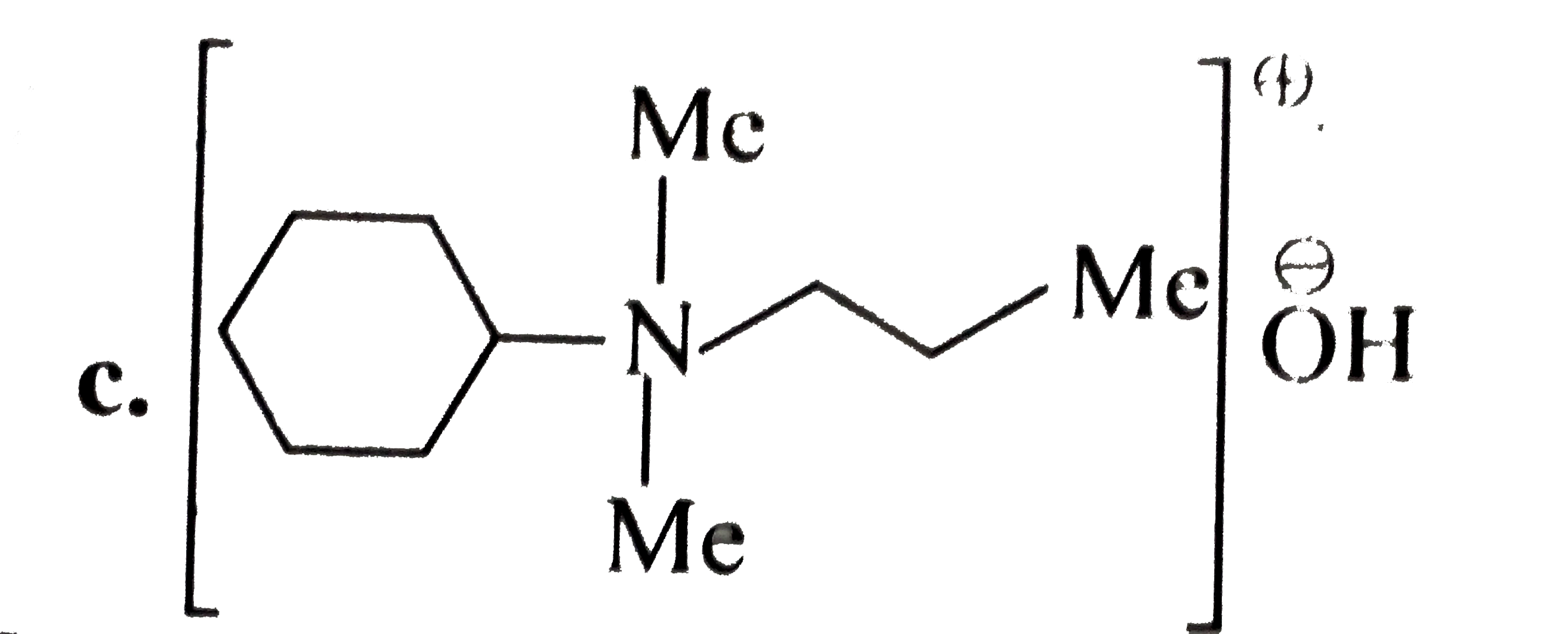Give the major alkene resulting from the thermal decomposition of hydroxide salt of the following:
[Ph⊕NMe3]ΘOH
b. ![Give the major alkene resulting from the thermal decomposition of hydroxide salt of the following: [Phoverset(o+)(N)Me(3)]overset(Theta)(OH) b. . c.](https://d10lpgp6xz60nq.cloudfront.net/physics_images/KSV_CHM_ORG_P2_C15_S01_023_Q01.png) .
.
c. 
a. (##KSVCHMORGP2C15S01023_S01.png width=80%><br>[{:("Compound does not have" beta-H"atom so"),(base (overset(Theta)OH) "displaces one Me group to"),(give MeOH and PhNMe_(2)):}]b.Thearethreed⇔erenttypesof Bate -Ha→ms.Themajor∏uctisobta∈edbytheremovalof H_awhichgives≤∗−⊂stitutedalke≠(I)<br><imga≤ocr_imageload∈g=lazysrc=https://d10lpgp6xz60nq.cloudfront.net/physics_images/KSV_CHM_ORG_P2_C15_S01_023_S02.pngwh=80%mx-autosty≤=background:white;><br>c. (##KSV_CHM_ORG_P2_C15_S01_023_S03.png" width="80%">.
Both the products (I) and (II) are possible .
Topper's Solved these Questions
- BOOK - CENGAGE CHEMISTRYCHAPTER - ORGANIC COMPOUNDS WITH FUNCTIONAL GROUPEXERCISE - Solved Examples12videos
ORGANIC COMPOUNDS WITH FUNCTIONAL GROUP
- BOOK - CENGAGE CHEMISTRYCHAPTER - ORGANIC COMPOUNDS WITH FUNCTIONAL GROUPEXERCISE - Exercises Subjective21videos
ORGANIC COMPOUNDS WITH FUNCTIONAL GROUP
- BOOK - CENGAGE CHEMISTRYCHAPTER - NUCLEAR CHEMISTRYEXERCISE - Archives Subjective13videos
NUCLEAR CHEMISTRY
- BOOK - CENGAGE CHEMISTRYCHAPTER - P-BLOCK GROUP 15 ELEMENTS - THE NITROGEN FAMILYEXERCISE - Exercises Archives (Subjective)28videos
P-BLOCK GROUP 15 ELEMENTS - THE NITROGEN FAMILY
Similar Questions
Give the star mark to the hydrogen which is most acidic in the following compounds:
(a) CH3−CH2−O∣∣C−CH2−CH3 (b) H2C=CH−CH2−O∣∣C−H
(c ) CH3−O∣∣C−O−CH2−CH3 (d) CH3−OH∣CH−O∣∣C−OHView SolutionGive the organic products of the following reactions :
(a) nPrBr+:O:∣∣N..−..O..:Θ
(b) i−Pr−Br+∣∣:..S..C≡N:∣∣Θ(Isocyanate)
(c) Et−Br+∣∣:..S..−SO3∣∣2Θ(Thiosulfate)
(d) C1(CH2)3I+CNӨ (One mole each)
(e) H2N(CH2)4Br−H⊕−−−→.
(f) Me−O−O∣∣S∣∣O(Dimethyl sulphate)−O−Me+EtSΘ→
(g) MeONO2(Methy1 nitrite)+NӨ3(FromNaN3)→
(h) MeCN+HSӨ→
( i) Me−O−O∣∣S∣∣Methyl fluorosulfonate−F+IΘ→.View Solution
Knowledge Check
- Question 1 - Select One
The thermal decomposition of the hydroxide salt of Ph+NMe3 gives .
ACH3OHBC6H5OHCC6H5CH2OHDCH3CH2OH - Question 2 - Select One
What is the major product obtained from the following reactions ?
HOCH2O∣∣COHSOCl2−−−→CH3OH−−−−→AHOCH2COOCH3BCH3OCH2COOCH3CClCH2COOCH3DCH3COCH2COOH - Question 3 - Select One
The decreasing fugacity order of the following is:
i. o−CN, ii. o−OH, iii. o−OMe, iv. o−CH3, v. Ho−A(v)>(iv)>(iii)>(ii)>(i)B(i)>(ii)>(iii)>(iv)>(v)C(iv)>(v)>(iii)>(ii)>(i)D(i)>(ii)>(iii)>(v)>(iv)
How many of the given nucleophiles will predominantly give substitution reaction with 3- bromo -cyclohexene?
ΘNH2HC=ΘCCH3CO¯¯¯O,ΘN3¯¯¯OH,C¯¯¯¯N,(CH3)3C¯¯¯O,CH3¯¯¯O,¯¯¯BHView SolutionThe major product of the following reaction is
CH3−CH=CH−O∣∣C−O−CH3LiAlH4−−−→View SolutionThe decreaing basic order of the following is:
i. o−CN, ii. o−OH, iii. o−OMe, iv. o−CH3, v. Ho−View SolutionAssertion: FeSO4andFe2(SO4)3 undergoes intramolecular redox reaction on thermal decomposition
Reason: Both salts give brown solid of Fe2O3 after decomposition.View SolutionAssertion: FeSO4andFe2(SO4)3 undergoes intramolecular redox reaction on thermal decomposition
Reason: Both salts give brown solid of Fe2O3 after decomposition.View Solution

